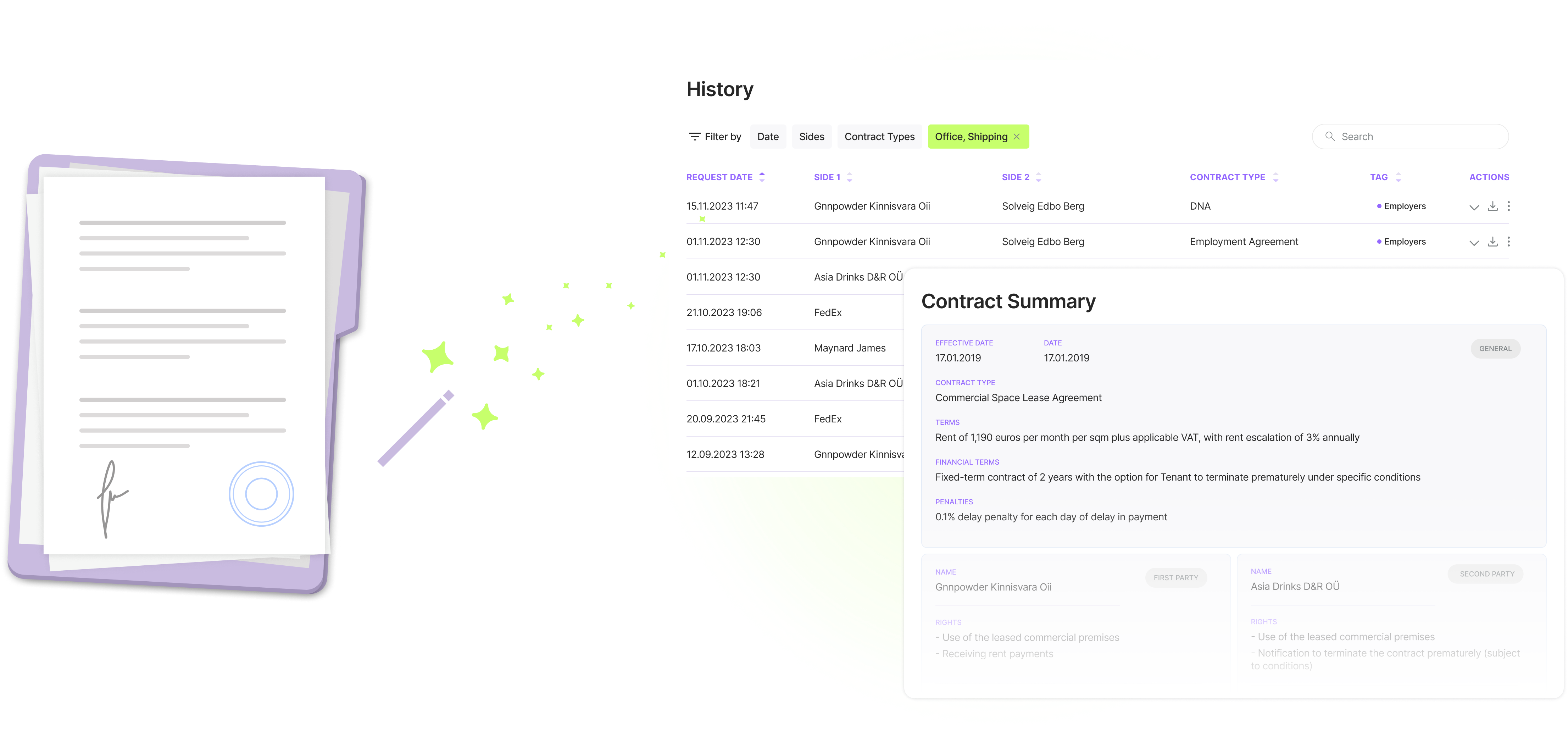
Security is a key. You interact with
Contract Crab peer-to-peer without
intermediaries, logging or human factor.

Powerful AI processes any amount of
information in seconds and gives back
an incredibly structured result.
Only you decide who has access to
your Contract Crab account. From our
side, we don’t log any information.




/contract
Document summarization and
review
Support .docx and .txt files
Complete document archive
Most popular!
/month
Document summarization and
review
Support .docx and .txt files
Complete document archive
Client services
/month
Document summarization and
review
Support .docx and .txt files
Complete document archive
Client services
Unlimited requests
/contract
1 document per cost
Summarization or AI Review
Support .docx and .txt files
Smart document archive
Most popular!
/month
120 documents
Summarize documents
Review documents
Support .docx and .txt files
Smart document archive
Customer support
/month
Unlimited documents
Summarize documents
Review documents
Support .docx and .txt files
Support .pdf files
Smart document archive
Premium customer support
For large teams and big challenges
/month
Document summarization and
review
Support .docx and .txt files
Support .pdf files
Complete document archive
Client services
Unlimited requests
Unlimited docsize
Complete privacy
Self hosted
Document summarization and
review
Support .docx and .txt files
Support .pdf files
Complete document archive
Premium Client services
Unlimited requests
Unlimited docsize
/month
Document summarization and
review
Support .docx and .txt files
Support .pdf files
Complete document archive
Client services
Unlimited requests
Unlimited docsize
Complete privacy
Self hosted
Document summarization and
review
Support .docx and .txt filess
Support .pdf files
Complete document archive
Premium Client services
Unlimited requests
Unlimited docsize
In the realm of legal automation, the cornerstone lies in leveraging technology to streamline complex legal processes. As we delve deeper into this domain, it’s crucial to understand what legal automation entails in 2024. At its core, legal automation involves the use of software and AI-driven tools to automate repetitive tasks, optimize workflows, and enhance overall efficiency in legal practice.
The role of AI in legal automation cannot be overstated. Artificial intelligence, powered by advanced algorithms and machine learning capabilities, plays a pivotal role in analyzing vast amounts of legal data and extracting valuable insights. Natural language processing (NLP) enables AI systems to understand and interpret complex legal documents, while semantic analysis identifies patterns and trends, empowering legal professionals with actionable information.
The benefits of legal automation are manifold. By automating routine tasks such as document review, contract management, and legal research, legal professionals can free up valuable time and resources. Moreover, automation improves accuracy and consistency, reducing the likelihood of errors and mitigating legal risks. In an era defined by increasing complexity and regulatory scrutiny, these advantages are more valuable than ever before.
As we navigate the ever-evolving landscape of legal tech automation, it’s essential to recognize the transformative potential of these technologies. From streamlining legal workflows to enhancing collaboration and communication, legal automation offers a pathway to greater efficiency and effectiveness in legal practice. In the following sections, we will explore some of the key applications of legal automation, examining how these technologies are reshaping the way legal work is conducted in 2024.
Legal workflows are often plagued by inefficiencies and bottlenecks that hinder productivity and increase the risk of errors. From manual document review processes to cumbersome approval workflows, there are numerous pain points that can impede the efficient delivery of legal services. Legal workflow automation software helps identify these pain points by providing insights into workflow performance and highlighting areas for improvement.
The key to effective legal workflow automation lies in leveraging technology to streamline and standardize processes. Modern legal workflow automation software offers a wide range of features and capabilities designed to simplify complex workflows. From automated document generation to task management and collaboration tools, these platforms provide legal teams with the tools they need to work more efficiently and effectively.
Effective collaboration and communication are essential for success in the legal profession. Legal workflow automation software facilitates collaboration by providing centralized access to documents and information, enabling team members to work together seamlessly. Moreover, automated notifications and reminders ensure that everyone stays informed and on track, reducing the likelihood of miscommunication or missed deadlines.
By streamlining legal workflows and enhancing collaboration, legal workflow automation software empowers legal professionals to focus their time and energy on high-value tasks that require human expertise. As the legal industry continues to embrace automation, these tools will play an increasingly important role in driving efficiency and innovation.
Document automation stands as a cornerstone of legal automation, offering significant time and cost savings for legal practices. In the traditional legal landscape, the creation, editing, and management of legal documents can be a labor-intensive and error-prone process. However, with the advent of advanced document automation tools, legal professionals can streamline these processes and ensure greater accuracy and compliance.
In the modern legal environment, the ability to generate and manage documents efficiently is crucial for maintaining competitiveness and delivering high-quality legal services. Document automation software simplifies this process by providing templates and workflows that streamline document creation and management. By automating repetitive tasks such as data entry and formatting, legal professionals can save time and focus on more strategic activities.
Advanced legal document automation tools leverage AI and natural language processing to enhance the document creation process further. These tools analyze the content of legal documents, identify key terms and clauses, and suggest relevant templates and boilerplate language. By automating document review and analysis, these tools help ensure consistency and accuracy across all legal documents.
Document management is a critical aspect of legal practice, with legal professionals often dealing with large volumes of documents on a daily basis. Document automation software streamlines the document management process by providing centralized storage and easy access to documents. Moreover, these tools offer version control and audit trail features, ensuring compliance and mitigating the risk of errors.
By simplifying legal document processes, document automation software enables legal professionals to work more efficiently and effectively. From contract drafting to case management, these tools offer tangible benefits that drive productivity and enhance client satisfaction. As the legal industry continues to embrace automation, document automation software will play an increasingly important role in shaping the future of legal practice.
In today’s regulatory environment, compliance and risk management are top priorities for legal professionals. The complexity and volume of regulations continue to increase, placing a significant burden on organizations to ensure compliance with legal requirements. Moreover, the consequences of non-compliance can be severe, ranging from financial penalties to reputational damage. In this context, automation plays a crucial role in helping organizations navigate regulatory challenges and mitigate legal risks effectively.
Compliance and risk management present numerous challenges for organizations, including staying abreast of regulatory changes, ensuring adherence to internal policies and procedures, and monitoring third-party activities. Manual processes for compliance monitoring and risk assessment are often time-consuming and prone to errors, leaving organizations vulnerable to regulatory scrutiny and legal action.
Automated compliance monitoring systems leverage technology to streamline the process of monitoring regulatory changes and ensuring compliance with legal requirements. These systems use AI and machine learning algorithms to analyze vast amounts of data from regulatory sources, industry publications, and internal policies. By automating the process of monitoring and analyzing regulatory changes, organizations can identify potential compliance issues proactively and take corrective action before they escalate.
In addition to compliance monitoring, automation also plays a crucial role in mitigating legal risks across various aspects of legal practice. From contract management to litigation support, automation helps ensure consistency, accuracy, and efficiency in legal processes. By automating routine tasks such as document review, contract analysis, and legal research, organizations can reduce the likelihood of errors and mitigate legal risks effectively.
By implementing automated compliance monitoring systems and leveraging automation across various aspects of legal practice, organizations can enhance their ability to ensure compliance and mitigate legal risks effectively. As the regulatory landscape continues to evolve, automation will become increasingly indispensable for legal professionals seeking to navigate complex regulatory requirements and safeguard their organizations against legal liabilities.
As legal automation continues to gain momentum, organizations must proactively embrace these technologies to stay competitive in the rapidly evolving legal landscape. However, successful implementation requires careful planning, strategic investment, and a commitment to fostering a culture of innovation. Here are some recommendations for organizations looking to leverage legal tech automation effectively:
To fully realize the benefits of legal tech automation, organizations must cultivate a culture of innovation that embraces change and encourages experimentation. Legal professionals should be empowered to explore new technologies, experiment with innovative solutions, and challenge traditional ways of working. By fostering a culture of innovation, organizations can unlock the full potential of legal tech automation and drive continuous improvement in legal practice.
Effective implementation of legal tech automation requires a skilled workforce capable of leveraging these technologies to their fullest potential. Organizations should invest in training and education programs to ensure that legal professionals have the knowledge and skills needed to effectively use automation tools. This may include providing training on specific automation platforms, as well as offering courses on AI, machine learning, and data analytics. By investing in the professional development of their teams, organizations can maximize the return on investment in legal tech automation.
Successful implementation of legal tech automation requires integration with existing workflows and processes. Organizations should carefully evaluate their current workflows and identify areas where automation can deliver the greatest impact. Automation tools should be seamlessly integrated into existing systems and processes to minimize disruption and maximize efficiency. Moreover, organizations should continuously monitor and evaluate the performance of automation tools to identify opportunities for optimization and improvement.
In the realm of legal automation, organizations have access to a diverse array of tools and technologies designed to streamline processes and enhance efficiency. From AI-powered contract management platforms to document automation software, there are numerous solutions available to meet the evolving needs of legal professionals. For example, ContractCrab, an innovative AI-powered tool, specializes in identifying key terms and clauses in contracts, simplifying the contract review process and saving valuable time for legal teams. By leveraging cutting-edge technology, tools like ContractCrab empower legal professionals to work more efficiently and effectively in today’s fast-paced legal environment.
By embracing a culture of innovation, investing in training and education, and integrating automation tools into existing workflows, organizations can unlock the full potential of legal tech automation and drive transformational change in legal practice. As the legal industry continues to evolve, organizations that embrace automation will gain a competitive edge and position themselves for long-term success.
As we conclude our exploration of legal automation in 2024, it is evident that technology has fundamentally transformed the practice of law. From streamlining legal workflows to enhancing compliance and risk management, automation has become an indispensable tool for legal professionals seeking to navigate the complexities of the modern legal landscape.
Looking ahead, the future of legal automation holds immense promise. As technology continues to advance, we can expect to see even greater innovations in the realm of legal tech automation. From AI-driven contract analysis to blockchain-powered smart contracts, the possibilities are endless.
At its core, legal automation is about empowering legal professionals to work more efficiently, effectively, and strategically. By automating routine tasks and streamlining workflows, technology allows legal professionals to focus their time and energy on high-value activities that require human expertise. Moreover, automation enhances collaboration, communication, and decision-making, enabling legal teams to deliver better outcomes for their clients.
As we look to the future, it is clear that organizations that embrace legal automation will gain a competitive edge in the legal industry. By investing in the right tools, training, and strategies, firms can position themselves for success in the digital age. Moreover, by fostering a culture of innovation and continuous improvement, organizations can adapt to the changing demands of the legal landscape and drive transformational change in the industry.
In conclusion, legal automation represents a paradigm shift in the way legal work is conducted. By harnessing the power of technology, legal professionals can streamline workflows, improve efficiency, and mitigate risks effectively. As we look ahead to the future of legal automation, it is imperative that organizations embrace these technologies and leverage them to their fullest potential. By doing so, they can unlock new opportunities, drive innovation, and ultimately, deliver better outcomes for their clients and stakeholders.
Contract Crab is an automated tool designed to extract key points and generate summaries from contracts and legal documents. While we strive for accuracy, the extracted information may not always be complete or error-free. Users should review and verify the extracted content for accuracy and completeness before relying on it.
Contract Crab does not provide legal advice or replace the need for professional legal consultation. The information extracted and provided by the service is for informational purposes only.
Users should consult with qualified legal professionals for specific legal guidance.
Users are responsible for the use of Contract Crab and any decisions made based on the extracted information.
Contract Crab and its creators are not liable for any consequences or damages resulting from the use of the service.
Contract Crab may process and store user data as necessary to provide its services. We are committed to protecting user data, but users should be aware of the privacy risks associated with uploading sensitive documents.
Contract Crab is an automated tool designed to extract key points and generate summaries from contracts and legal documents. While we strive for accuracy, the extracted information may not always be complete or error-free. Users should review and verify the extracted content for accuracy and completeness before relying on it.
Contract Crab does not provide legal advice or replace the need for professional legal consultation. The information extracted and provided by the service is for informational purposes only.
Users should consult with qualified legal professionals for specific legal guidance.
Users are responsible for the use of Contract Crab and any decisions made based on the extracted information.
Contract Crab and its creators are not liable for any consequences or damages resulting from the use of the service.
Contract Crab may process and store user data as necessary to provide its services. We are committed to protecting user data, but users should be aware of the privacy risks associated with uploading sensitive documents.